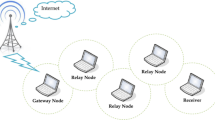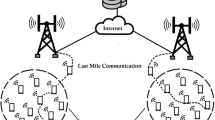Abstract
With the exponential growth of the internet, wireless networks such as satellite networks are becoming increasingly popular. The characteristics of satellite networks such as long latency, large delay-bandwidth product, high bit error rate over satellite links and variable round trip time, severely degrade TCP/IP performance. At the conjunction of the satellite link and the fixed link, the basestation, the difference in capacity between the satellite link and the fixed link causes the basestation to experience congestion losses that adversely impact TCP performance. We propose a technique that substantially reduces the congestion at the base station and enforces fairness among the TCP connections that are sharing the satellite link. The technique does not require any change in the TCP sender or the receiver. The stability of our algorithm is analytically proven and its performance is evaluated using ns-2 simulations. Preliminary results yield almost a null congestion loss rate, a 60% decrease in average queue length, and more than 30% increase in the throughput. Fairness is well enforced.












Similar content being viewed by others
Notes
In the rest of the text, we will justify why we use the expression “flow control” instead of congestion control.
We apply the reducing factor twice when \({\frac{Q_l^j} {Q_{Max}}} > 0.3.\)
References
Bakre, A., & Badrinath, B. (1995). I-TCP: Indirect TCP for mobile hosts. In Proceedings of the 15th international conference on distributed computing systems (ICDCS) (pp. 152–159), May 1995.
Balakrishnan, H., Padmanabhan, V., Seshan, S., & Katz, R. (1996). A comparison of mechanisms for improving TCP performance over wireless links. In ACM SIGCOMM’96 (pp. 152–159), August 1996.
Balakrishnan, H., Seshan, S., Amir, E., & Katz, R. (1995). Improving TCP/IP performance over wireless networks. In ACM international conference on mobile computing and networking conference—Mobicom ’95, Berkeley, November 1995.
Barowski, Y. D., Biaz, S., & Agrawal, P. (2005). Toward the performance analysis of ieee 802.11 in multi-hop ad-hoc networks. In IEEE wireless communications and networking xonference, WCNC 2005, New Orlean, LA, March 2005.
Bianchi, G. (2000). Performance analysis of the IEEE802.11 distributed coordination function. IEEE Journal in Selected Areas: Communication, 18, 535–547.
Chiu, D.-M., & Jain, R. (1989) Analysis of the increase and decrease algorithms for congestion avoidance in computer networks. Journal of Computer Networks and ISDN, 17, 1–14.
Fraleigh, C., Moon, S., Christophe Diot, B. L. & Tobagi, F. (2001). Packet-level traffic measurements from a tier-1 IP backbone. Tech. Rep. TR01-ATL-110101, SPRINT, November 2001.
Katabi, D., Handley, M., & Rohrs, C. (2002). Internet congestion control for future high bandwidth-delay product environments. In Proceedings of SIGCOMM’02, ACM, August 2002.
Martin, H.S., McGregor, A., & Cleary, J. G. (2000). Analysis of Internet delay times. In PAM 2000: Passive and active measurements workshop, Auckland, New Zealand, April 2000.
McCreary, S., & Claffy, K. (2000). Trends in wide area IP traffic patterns—a view from ames internet exchange. In ITC specialist seminar, pp. 18–20, September 2000.
Stadler, J., & Gelman, J. (1997). A link layer protocol for efficient transmission of TCP/IP via satellite. In Military communications conference,MILCOM, Montery, CA, November 1997.
Stadler, J., & Gelman, J. (1998). Performance enhancement for TCP/IP on a satellite channel. In Military communications conference, MILCOM, Lexington, MA, July 1998.
Henderson, R. K. T. R. (1997). Satellite transport protocol (stp): An sscop-based transport protocol for datagram satellite networks. 2nd international workshop on satellite-based information Services, vol. 1, October 1997.
USC/ISI/ACIRI. VINT project U.C. berkeley/LBNL, ns2:network simulator. http://www.isi.edu/nsnam/ns.
Author information
Authors and Affiliations
Corresponding author
Rights and permissions
About this article
Cite this article
Biaz, S., Dai, Y. Basestation flow control for wired to wireless networks. Wireless Netw 16, 775–791 (2010). https://doi.org/10.1007/s11276-009-0168-z
Published:
Issue Date:
DOI: https://doi.org/10.1007/s11276-009-0168-z




